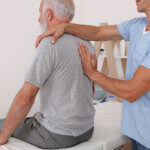Elbow and shoulder pain can have a significant impact on your daily life. It can keep you from doing your everyday tasks and activities. Understanding the complex anatomy and potential issues associated with these joints is crucial for receiving a diagnosis and effective treatment. The elbow is a joint formed by the humerus, radius and ulna bones. It also has ligaments and tendons to provide stability and allow for movements of the forearm. The shoulder is a highly mobile ball-and-socket joint formed by the humerus, scapula and clavicle. The rotator cuff is a group of muscles and tendons that plays a crucial role in the shoulder’s stability and wide range of movement.
Symptoms of elbow and shoulder pain
Recognizing the symptoms associated with elbow and shoulder pain is vital to understand the underlying issue and seek appropriate medical attention. Common symptoms associated with elbow and shoulder pain include:
- Radiating pain.
- Tenderness.
- Swelling.
- Stiffness.
- Reduced range of motion.
- Numbness or tingling.
- Weakness.
- Clicking, popping or grinding.
- Instability.
- Painful grasping or grabbing.
- Pain with specific activities.
- Visible deformity.
If you are experiencing persistent or worsening elbow and shoulder pain symptoms, seeking medical attention is essential.
Cause of elbow and shoulder pain
Knowing why you’re experiencing shoulder and elbow pain is the first treatment step. Pain can be caused by a variety of issues, including:
- Rotator cuff tendinitis — The rotator cuff muscle group is crucial for helping to stabilize the upper shoulder bone. Rotator cuff tendinitis can induce pain and swelling in your shoulder and is primarily caused by repetitive pressure and shocks during physical activities.
- Overuse — Overusing the shoulder and elbow joints can cause bone and tendon injuries caused by friction and tears. Inadequate rest can make this issue worse and cause pain to worsen.
- Frozen shoulder — Stiffness and limited mobility are characteristics of a frozen shoulder. This condition can result from inflammation that is associated with arthritis. The shoulder becomes immobilized during movement and causes discomfort and reduced mobility.
- Sprain — Shoulder ligament tears can result from weak ligaments, excessive use, lack of exercise or an external impact. Swelling and soreness can make it difficult to do everyday activities.
- Arthritis — Osteoarthritis and rheumatoid arthritis can lead to reduced mobility, increased inflammation, and pain in the shoulder and elbow.
- Shoulder dislocation — Shoulder dislocations are common in high-contact sports. This painful condition occurs when the humerus’s top pops out of the shoulder socket. It can also result in tendon and cartilage tears.
Treatment for elbow and shoulder pain
Several treatment options are available, whether your pain stems from rotator cuff tears to nerve compression. These treatment options can include:
- Rest and immobilization — Resting your elbow and shoulder by using splints or braces to immobilize the area can help promote healing, especially in cases of overuse or trauma.
- Physical therapy — Physical therapy can play a beneficial role in helping to rehabilitate elbow and shoulder conditions. Your physical therapists can focus on helping you strengthen, stretch, and improve range of motion.
- Medication — NSAIDs or corticosteroid injections may be prescribed to help you manage pain and inflammation.
- Heat and cold therapy — At home, using a heating pad or ice packs for heat or cold therapy, respectively, can help alleviate your pain and reduce inflammation due to numerous shoulder or elbow conditions.
- Surgery — In severe cases, it may be necessary for surgical intervention to help repair fractures or tears or correct joint instability.
Physical therapy for elbow and shoulder pain
Physical therapy can be a successful, nonsurgical approach for various elbow and shoulder conditions. Beneficial physical therapy techniques can include:
- Manual therapy — Physical therapists use hands-on techniques like soft tissue mobilization and joint mobilization to help improve mobility, reduce pain, and boost the function of your shoulder and elbow.
- Electrical stimulation — Electrical stimulation is a technique that can help stimulate nerves and muscles. This stimulation can help promote pain relief, reduce inflammation, and aid in muscle contraction and relaxation.
- Therapeutic exercises — Therapeutic exercises can be tailored to individual needs and are a cornerstone of rehabilitation for elbow and shoulder pain. These exercises can focus on strengthening muscles, improving flexibility and boosting overall joint function.
- Instrument-assisted soft tissue mobilization (IASTM) — IASTM uses specialized tools to help massage and manipulate soft tissue, which can aid in the breakdown of scar tissue and help promote healing.
- Dry needling — Performed by a certified physical therapist by inserting thin, sterile needles into muscle trigger points, dry needling is intended to alleviate pain and improve your range of motion. This can be beneficial in helping elbow and shoulder conditions that result in myofascial pain.
Elbow and shoulder pain can be caused by a variety of causes ranging from overuse to underlying medical conditions. Understanding the complexity of these joints, common conditions and available treatments is essential to help manage and alleviate your pain. A multidisciplinary approach, including physical therapy, can be critical to achieving pain relief.
Find treatment for your elbow and shoulder issue with Peak Performance
At Peak Performance, we understand that shoulder and elbow pain can present formidable obstacles to achieving your normal activities and routines. Our dedicated team of expert physical therapists specializes in addressing these challenges keeping you from your best life. As you start your rehabilitative journey with us, our team will design a custom approach that helps address not only your symptoms but also the underlying issue causing your pain. We are committed to helping you beyond just healing. We strive to empower you to surpass your physical limitations and embrace the lifestyle of sustained excellence you deserve.
Call us or request an appointment today to uncover the cause of your shoulder and elbow pain.







